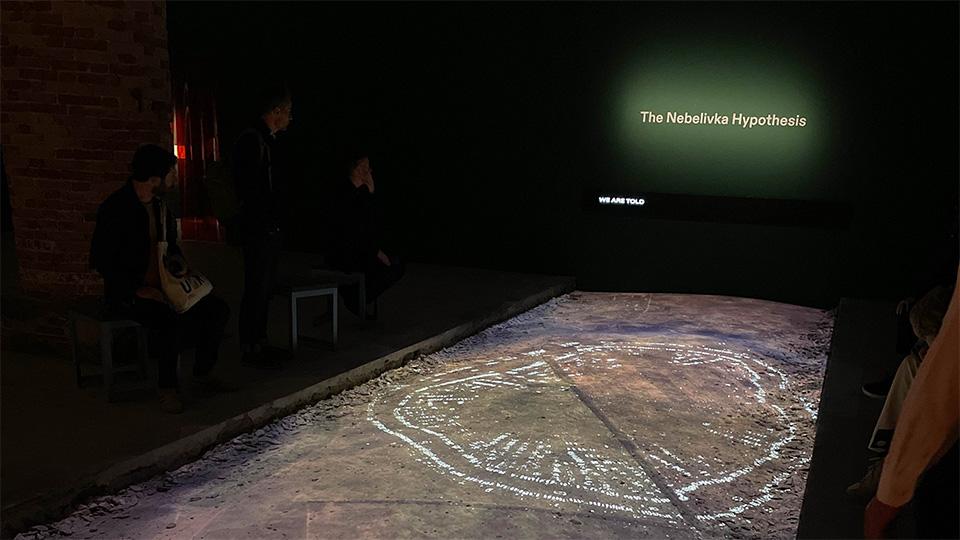Forensic Architecture project at Venice Biennale
Primary page content
A multimedia exhibition exploring the concept of cities and urbanism through the lens of a 6,000-year-old Ukrainian archaeological site is currently on display at the Venice Biennale of Architecture.

An installation shot of the exhibition in Venice
The project is a unique collaboration between Goldsmiths Forensic Architecture (FA) group and David Wengrow, a practitioner of pre-historical archaeology at University College London (UCL).
Combining archaeological science with the tools of FA, the project presents evidence that unsettles the position of the State as a telos of human history.
It charts the recovery of a lost tradition of urban life below the soils of the Ukrainian steppe, and how this process reflects wider transformations in the discipline of archaeology, its technologies and its sensibilities. Evidence is no longer simply ‘unearthed’ from the ground; rather the soil is examined as an archive of historical knowledge in its own right.
David Wengrow from UCL’s recent best-selling book with David Graeber, The Dawn of Everything: A New History of Humanity (2021) has broken new ground in our understanding of ancient cities and provides a conceptual basis for this further line of inquiry.
The book contests received wisdom that the first cities were incubators for a new form of political life—namely, the State, with its faceless bureaucracy, ruling elites, and techniques of surveillance and control. Instead, it charts the recovery of lost urban traditions from various parts of the world, which reveal a kaleidoscope of possible trajectories, including early experiments in social housing and egalitarian cities.
Eyal Weizman, Forensic Architecture’s director, said: “When reading The Dawn of Everything I was struck by how the authors mobilised architectural evidence – buildings, town squares, cities, environments – to unsettle the received history of human inhabitation, cities, and the way they inevitably lead to state and empire. I felt this was the most ambitious project of architectural ‘counter-forensics’ I had seen.
“The collaboration led to a journey that took us through the evidence, Soviet era archaeology – using aerial detection and magnetometry – and contemporary practices deeply attuned to the soil... to its surprising final speculation...”
David Wengrow, archaeologist and author, said: “The genesis of this project lies in a conversation with Eyal Weizman, where he suggested to me that – despite their radically different scales of analysis – there was a kind of affinity between the methods David Graeber and I employed in The Dawn of Everything, and the procedures undertaken by Forensic Architecture.
“In seeking to challenge the authority of state narratives by extracting counter-archives of information from physical crime scenes, Weizman’s approach is aligned with our project of finding evidence in the archaeological record to confront established theories, which position the modern State as a telos of human social development.”
FA is a group otherwise dedicated to investigating human rights violations and war crimes, including bomb sites from Gaza to Ukraine. The interdisciplinary research agency undertakes special and media analysis for international prosecutors, human rights groups and NGOs.
Davide Piscitelli, a Forensic Architecture researcher, said: “The Nebelivka Hypothesis explores the deep-rooted connection between the practice of Forensic Architecture and the new archaeological practice described by David Graeber and David Wengrow in The Dawn of Everything.
“The project is a starting point for new ways of thinking through practice, where alternative methodologies and new possibilities emerge from the analysis of material evidence – satellite and geophysical analysis, simulation as a tool of speculation and soil reconstruction.”
Forensic Architecture (FA) is an interdisciplinary research agency based at Goldsmiths, University of London. FA undertakes spatial and media analysis for international prosecutors, human rights groups and NGOs. Its research is presented in political and legal forums, truth commissions, courts, and human rights reports, as well as in exhibitions and public events.
To find out more and read about the investigations visit the Forensic Architecture website.